|
MONS PEAK IX TIGER PAW 7075 TREKKING
POLES
TEST SERIES BY BRIAN
HARTMAN
INITIAL REPORT
May 20, 2018
CLICK
HERE TO SKIP TO THE FIELD REPORT
CLICK
HERE TO SKIP TO THE LONG-TERM REPORT
TESTER INFORMATION
| NAME:
|
Brian Hartman
|
| EMAIL:
|
bhart1426ATyahooDOT com |
| AGE:
|
50 |
| LOCATION:
|
Westfield,
Indiana |
| GENDER:
|
M
|
| HEIGHT:
|
5' 9" (1.75
m) |
| WEIGHT:
|
155 lb (65.80
kg) |
I have been backpacking for over
25 years throughout Indiana, Ohio, Kentucky and most recently in Western USA.
In addition to backpacking I enjoy family camping with my wife and kids and
being outdoors in general. I would describe myself as a mid weight backpacker.
I use fairly light weight equipment and gear but still like to bring more than
the bare essentials with me while on the trail.
INITIAL REPORT
PRODUCT INFORMATION &
SPECIFICATIONS
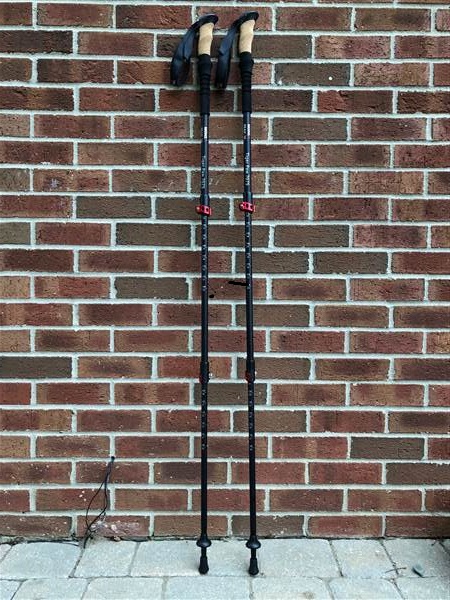
Manufacturer: Mons Peak IX
Year of Manufacture: 2018
Manufacturer's Website: https://www.monspeakix.com/
MSRP:
US $94.95
Listed Weight: 17.3 oz per pair (490 g)
Measured Weight: 17.6
oz (498 g)
Length: 24.5 - 53.1 in (62 - 135 cm)
Other Details:
Shock Absorbers: No
Basket Style: Performance Baskets plus Snow Baskets
# of Sections: 3
Locking Mechanism: Snap-Click Compression Locks
7075 Anodized Aluminum
Cork and Polymer Hand Grips
Adjustable Wrist Straps
Carbide Tips
Rubber Tip Protectors
Made in China
INITIAL IMPRESSIONS
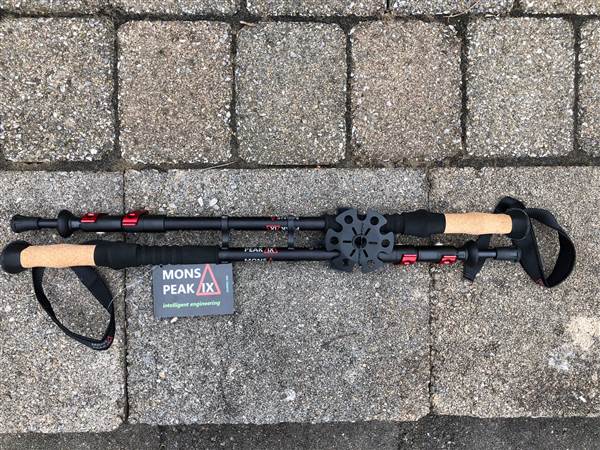 The Mons Peak IX Tiger Paw 7075 trekking poles (hereafter called
trekking poles or Tiger Paws) arrived in a plain rectangular box.
The box was about what I expected in terms of size and weight as
I had researched the poles ahead of time and knew their specifications.
After removing the poles from their shipping box, I found them to
be in new condition and well designed. They are made of 7075 aircraft
grade aluminum that has been anodized to make it harder, more durable,
and less likely to corrode. The poles are jet black in color and
have the manufacturer's logo and the words 'Tiger Paw 7075' laser
marked in silver on the side of them. The top of the poles,
baskets, and tips are also black while the compression locks are red,
and the cork grips are "whatever color cork is". Overall, the
poles make a great first impression. I really like the color
combination and would say they look sharp and well-refined or
high-class as far as trekking poles go. The cork grips are
contoured, and they just happen to be the perfect length and diameter
for my hands. The poles were collapsed into three sections when
they are arrived, with each section measuring approximately 18 inches
(46 cm). The height of the poles is adjusted via two snap-click
compression locks that allow them to telescope inside of each other.
Silver markings on the sides of the telescoping sections list the
total height of the poles in inches as well as centimeters. The
locks are comprised of lightweight anodized aluminum levers, threaded
steel rods and nuts, and polymer rings that compress around the pole
sections to keep them from collapsing once tightened. The nuts
have knurled sides which should make it easier to tighten and loosen
them.
The Mons Peak IX Tiger Paw 7075 trekking poles (hereafter called
trekking poles or Tiger Paws) arrived in a plain rectangular box.
The box was about what I expected in terms of size and weight as
I had researched the poles ahead of time and knew their specifications.
After removing the poles from their shipping box, I found them to
be in new condition and well designed. They are made of 7075 aircraft
grade aluminum that has been anodized to make it harder, more durable,
and less likely to corrode. The poles are jet black in color and
have the manufacturer's logo and the words 'Tiger Paw 7075' laser
marked in silver on the side of them. The top of the poles,
baskets, and tips are also black while the compression locks are red,
and the cork grips are "whatever color cork is". Overall, the
poles make a great first impression. I really like the color
combination and would say they look sharp and well-refined or
high-class as far as trekking poles go. The cork grips are
contoured, and they just happen to be the perfect length and diameter
for my hands. The poles were collapsed into three sections when
they are arrived, with each section measuring approximately 18 inches
(46 cm). The height of the poles is adjusted via two snap-click
compression locks that allow them to telescope inside of each other.
Silver markings on the sides of the telescoping sections list the
total height of the poles in inches as well as centimeters. The
locks are comprised of lightweight anodized aluminum levers, threaded
steel rods and nuts, and polymer rings that compress around the pole
sections to keep them from collapsing once tightened. The nuts
have knurled sides which should make it easier to tighten and loosen
them.
The
Tiger Paw 7075 is one of three trekking poles that Mons Peak IX has
added to its product portfolio. What makes these poles standout,
according to the manufacturer is 1) their rugged pole design,
which use aircraft grade aluminum for strength and durability 2)
their snap-click compression locks, which are lightweight and
easy-to-use and finally 3) their cork and polymer hand grips, which are
comfortable to grip during long trail days.
READING THE INSTRUCTIONS
A small hang tag was
attached to the Tiger Paw trekking poles. It listed their length and
weight as well as the manufacture's website. Online Mons Peak
noted that the poles were designed and built for 4 season use with
emphasis on ruggedness, ease-of-use, strength, and value. Pole
maintenance is as simple as wiping them down after use
and allowing them to dry completely before putting them away.
TRYING THEM OUT
I took the Tiger Paws to
a local park for a quick test and found them to be comfortable and easy
to use. I had no problem fine tuning them to the proper height
and after a few quick adjustments of the compression locks, they stayed
exactly where I set them. While hiking I switched between the
carbide tips and rubber caps and found that both were effective, the
carbide tip more so on gravel and dirt, while the rubber tips came in
handy on the sections of trail that were paved. At the end of my
hike I simply collapsed the poles to their folded position and set them
in the backseat of my car. One thing I noticed upon initial
inspection of the poles, is that one of the cork grips has an obvious
crack in it that extends up from the bottom of the grip. The
crack is deep and approximately 0.5 in (1.3 cm) in length. I will
continue to monitor this situation as I'm concerned it may open up
further and ruin the grip or allow water and dirt to get in which could
create other problems. 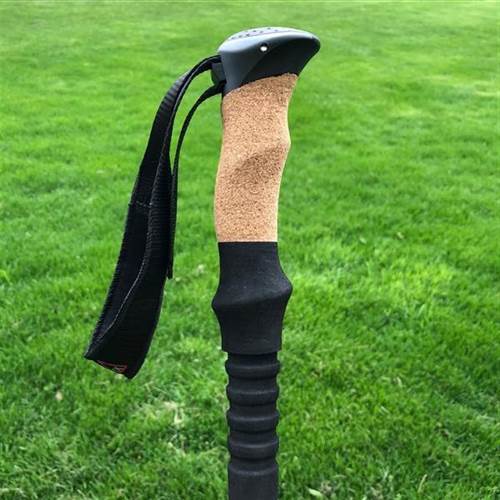 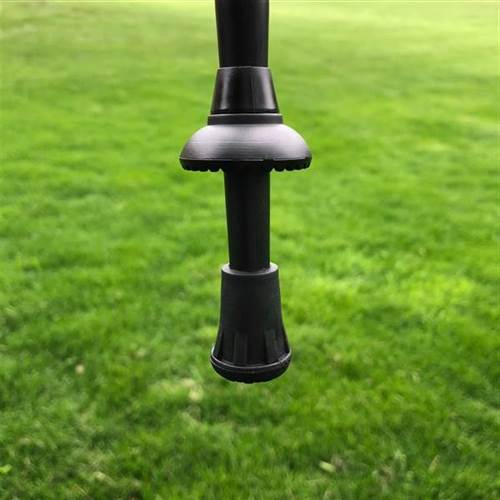
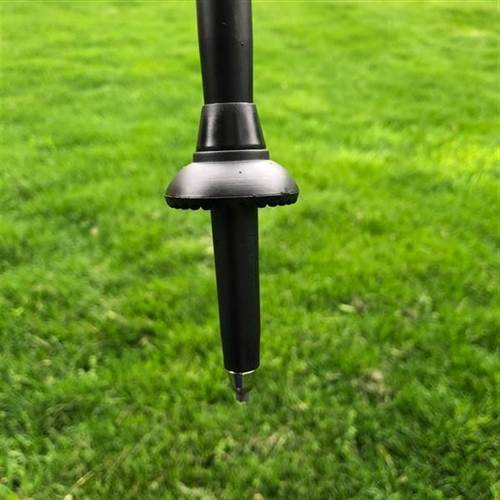
One
thing I did not do during my brief hike was adjust the wrist straps.
Out of habit I simply gripped right over the top of them.
Once I get these poles on the trail I will be curious to see how
well the straps work and if they cause any discomfort or abrasions as
the nylon webbing rubs on the backs of my hands and wrists. 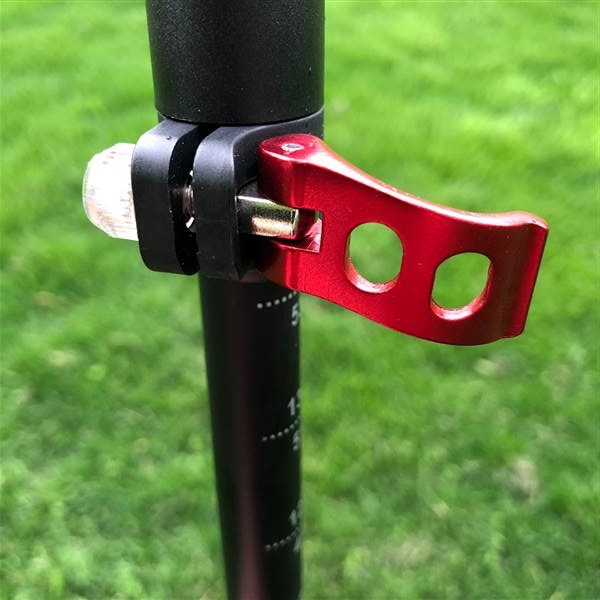 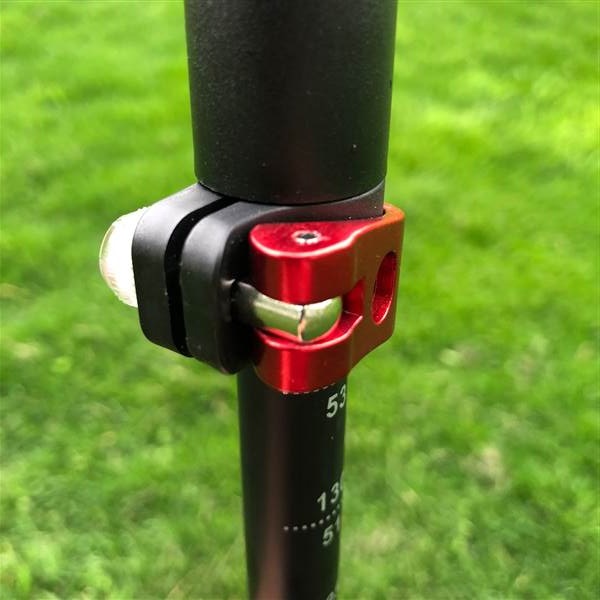
SUMMARY
The Tiger Paw trekking
poles are light weight and compact but even more important, they appear
to be well-crafted and durable. I look forward to putting them
through rigorous testing on my trip out West. This concludes my Initial
Report for the Tiger Paw trekking poles. I will post a Field Report in
approximately two months so please check back then to see how well they
fared. In the meantime, thanks to Mons Peak IX and
BackpackGeartest.org for the opportunity to test these poles. This concludes my Initial Report for the
ColdPruf Merino wool base layers.
FIELD
REPORT July 29, 2018
FIELD LOCATIONS AND CONDITIONS
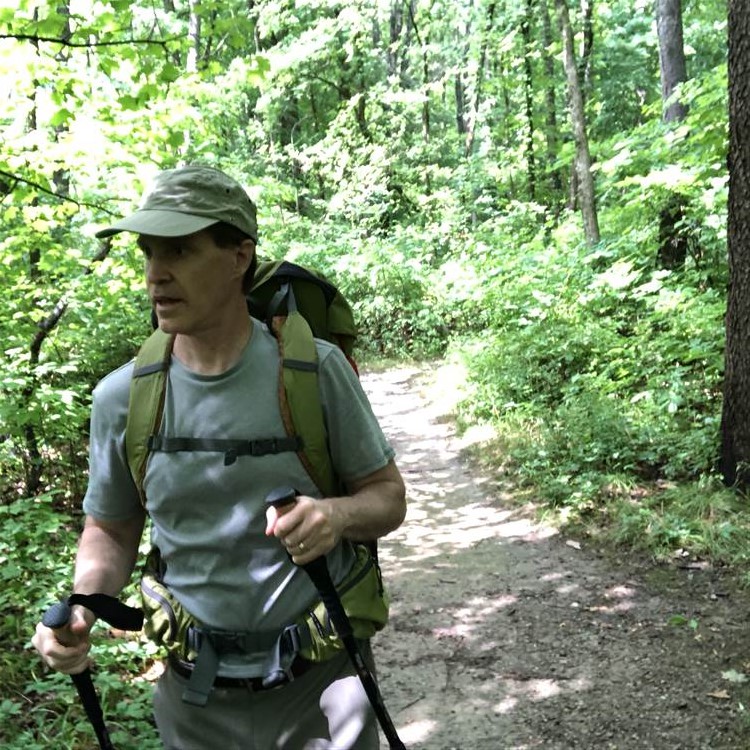 During
the past two months I hiked approximately 27 mi (44 km) with the Tiger
Paw trekking poles. I logged these miles via a combination of
overnight backpacking trips and day hikes. My first overnight
trip was to the Hoosier National Forest where I spent two days hiking
on mostly established trails. Temperatures ranged from 66 to 76 F
(19 to 24 C) with light winds and mostly sunny skies. The terrain
was hilly, and the hard-packed dirt trails were soggy from rain that
was falling intermittently throughout the day. While there I
hiked 12 miles (19 km) through dense forests that occasionally opened
up to views of Lake Monroe, the largest lake in Indiana at over
10,000 acres. Elevations ranged from 550 ft (168 m) to 790 ft
(241 m). My second overnight trip was to Southeastern Indiana
(IN) near Oldenburg where temperatures were ideal with daytime highs of
72 F (22 C) and overnight lows in the mid 60s F (18 C). I hiked
approximately 6 mi (9.7 km) on this trip. In addition to these
trips I went on several day hikes in Central Indiana to complete my
testing. During
the past two months I hiked approximately 27 mi (44 km) with the Tiger
Paw trekking poles. I logged these miles via a combination of
overnight backpacking trips and day hikes. My first overnight
trip was to the Hoosier National Forest where I spent two days hiking
on mostly established trails. Temperatures ranged from 66 to 76 F
(19 to 24 C) with light winds and mostly sunny skies. The terrain
was hilly, and the hard-packed dirt trails were soggy from rain that
was falling intermittently throughout the day. While there I
hiked 12 miles (19 km) through dense forests that occasionally opened
up to views of Lake Monroe, the largest lake in Indiana at over
10,000 acres. Elevations ranged from 550 ft (168 m) to 790 ft
(241 m). My second overnight trip was to Southeastern Indiana
(IN) near Oldenburg where temperatures were ideal with daytime highs of
72 F (22 C) and overnight lows in the mid 60s F (18 C). I hiked
approximately 6 mi (9.7 km) on this trip. In addition to these
trips I went on several day hikes in Central Indiana to complete my
testing.
Location: Hoosier National Forest
Type of trip: On-trail hiking
Distance: 12 mi (19 km)
Length of trip: Two nights
Backpack weight: 31 lb (14 kg)
Conditions: Overcast with intermittent rain showers
Precipitation: 0.3 in (0.76 cm)
Temperature range: 66 to 76 F (19 to 24 C)
Location: SE Indiana
Type of trip: Off-trail hiking
Distance: 6 mi (9.7 km)
Length of trip: Two nights
Backpack weight: 34 lb (17.7 kg)
Conditions: Mostly sunny
Precipitation: None
Temperature range: 66 F to 72 F (18 to 22 C)
Location: Various parks in Central Indiana
Type of trip: On-trail hiking
Distance: 10 mi (16 km)
Length of trip: Multiple day trips
Backpack weight: 9 lb (4 kg)
Conditions: Hot and humid. It rained on two of my day hikes.
Precipitation: 0.4 in (1.0 cm)
Temperature range: Varied from 84 to 92 F (29 to 33 C)
PERFORMANCE IN THE FIELD
The Tiger Paws performed
well during the past two months of Field Testing. They were easy
to setup, comfortable to use, and proved to be strong and
durable. I adjusted them per the manufacturer’s recommendations
so that my elbows were bent at 90 degrees while standing up straight
and gripping the poles. When not using the trekking poles, which
wasn’t very often, I collapsed them and strapped them to the outside of
my pack. Most of the time, however, they were in my hands, as the
places I hiked were hilly and occasionally muddy and slippery.
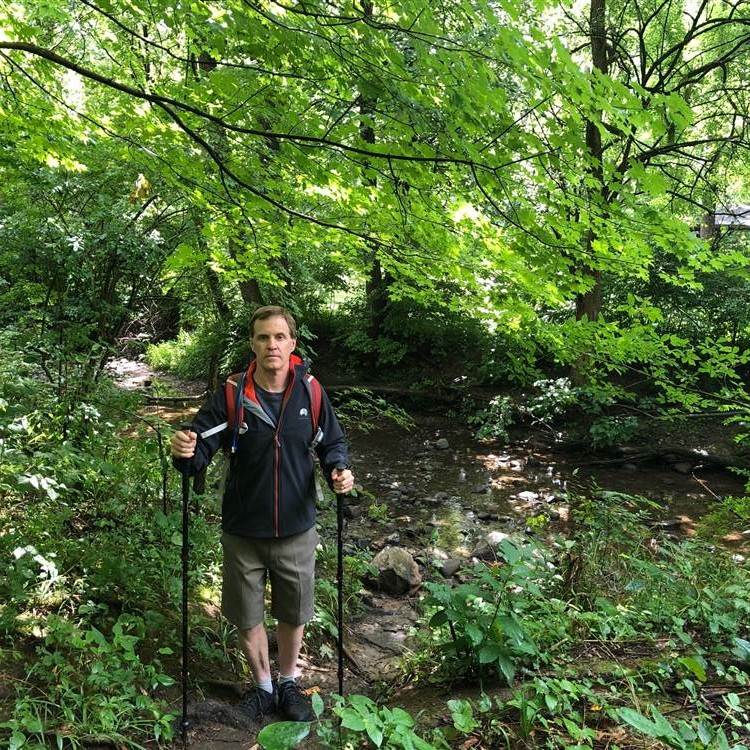 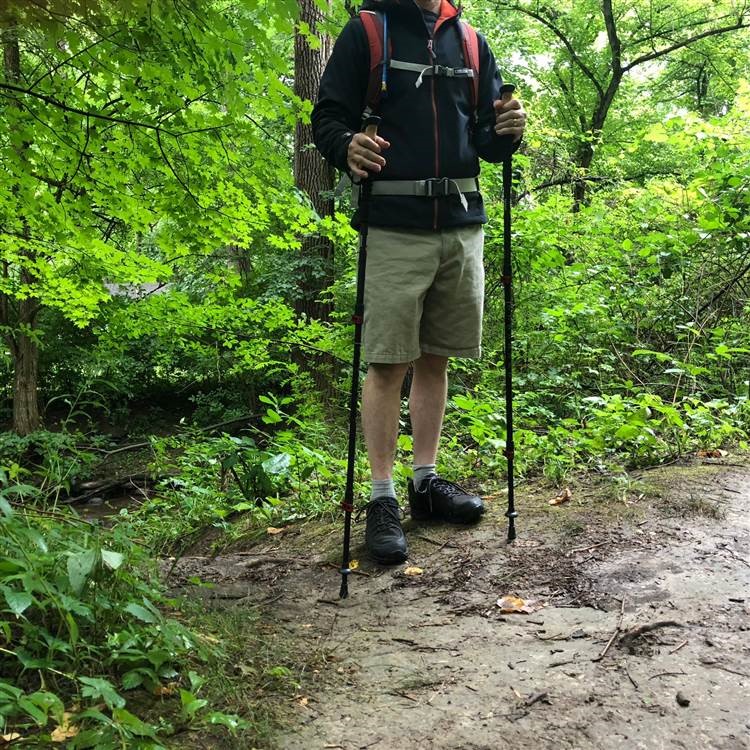
Performance:
The Tiger Paws did a great job keeping me upright and stable in all
kinds of terrain, including slippery trails, steep hillsides, rocky
creek beds, and even when hiking off-trail through brush and down muddy
hillsides. In fact, they were ideal for off-trail hiking as I
used the poles to push aside briars and thorns so my legs and arms
didn’t get cut up. They also helped me make it across several
deep creeks without getting soaked because I was able to plant the
poles in the water to balance myself while stepping across the
rocks which were slippery and often lose. The closest I came to
falling though was when I was hiking off-trail and tried to descend a
steep muddy hillside to avoid some barbed wire that was blocking my
path. When I lost traction on the sheer slope and my feet started
sliding out beneath me, the poles kept me balanced so that I was able
to stay vertical and glissade down the hill rather than land on my butt.
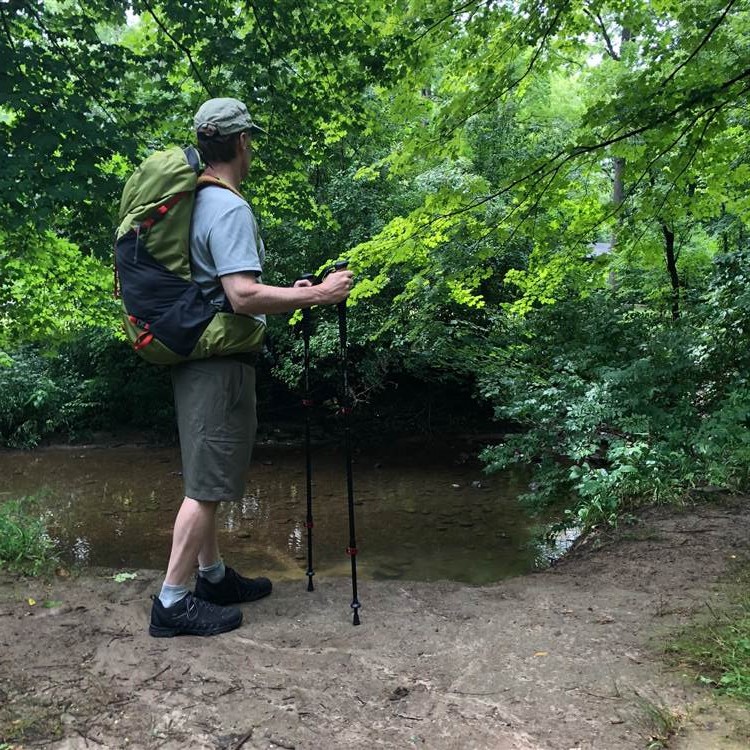 Comfort
/ Fit: The cork hand grips were easy to grasp and comfortable to hold
onto for hours at a time. My hands never slipped off the grips
and there was plenty of cushion to prevent hot spots and blisters
despite the fact that I worked the poles hard while hiking both uphill
and downhill. One thing that wasn’t comfortable though, was the
wrist straps. Although the nylon webbing was sturdy and I doubt
it would ever break, it just wasn’t comfortable, as it rubbed against
my skin throughout the day. I would like to see a piece of soft
fabric sewn over their straps to ease the friction from the constant
rubbing that occurs when using trekking pole straps. Of
course, it didn’t help that the backs of my hands were sunburned from
the previous day. As for fit, the poles had plenty of length and
fit my height just fine. Adjusting the height of the poles was
easy to do with the snap-click compression locks, and once locked, the
poles never slipped. Regarding weight, the Tiger Paws 7075
weren’t ultra-lightweight but they also weren’t overly heavy. I
never felt like they were slowing me down or I was burning a lot of
energy by using them. Comfort
/ Fit: The cork hand grips were easy to grasp and comfortable to hold
onto for hours at a time. My hands never slipped off the grips
and there was plenty of cushion to prevent hot spots and blisters
despite the fact that I worked the poles hard while hiking both uphill
and downhill. One thing that wasn’t comfortable though, was the
wrist straps. Although the nylon webbing was sturdy and I doubt
it would ever break, it just wasn’t comfortable, as it rubbed against
my skin throughout the day. I would like to see a piece of soft
fabric sewn over their straps to ease the friction from the constant
rubbing that occurs when using trekking pole straps. Of
course, it didn’t help that the backs of my hands were sunburned from
the previous day. As for fit, the poles had plenty of length and
fit my height just fine. Adjusting the height of the poles was
easy to do with the snap-click compression locks, and once locked, the
poles never slipped. Regarding weight, the Tiger Paws 7075
weren’t ultra-lightweight but they also weren’t overly heavy. I
never felt like they were slowing me down or I was burning a lot of
energy by using them.
Durability / strength: During the past two
months the poles were quite durable. I had no issues with them
and am actually quite impressed with the grade of aluminum that was
used in their construction. According to Mons Peak, it is 7075
which is also known as aircraft grade aluminum, known for its
strength. The compression locks proved to be very reliable.
Once tightened, they didn't slip and were easy to adjust. On a
down note, the crack in the one cork hand grip opened up slightly so
after getting home I coated that area with a thinned down solution of
Elmer’s glue, which hopefully will prevent it from getting worse.
Of final note, the pole tips and baskets are still in good shape, with
normal wear, despite being subjected to gravel, weeds and vines,
and getting wedged between rocks.
SUMMARY
The Mons Peak Tiger Paw
7075 trekking poles have lived up to their manufacturer’s claim of
being rugged, easy to use, strong and a good value. They are
built tough and yet they are comfortable to use on extended mileage
backpacking trips. I started using trekking poles eight years
ago, and immediately saw the benefits. Since then I take them
with me whenever I go backpacking.
This concludes my Field
Report for the Tiger Paw trekking poles. Please come back in two
months to read my final report on these poles. In the meantime,
thanks to Mons Peak and BackpackGearTest.org for the opportunity to
test these poles.
LONG TERM REPORT September 29, 2018
LONG-TERM TEST LOCATIONS AND CONDITIONS 
During
Long Term Testing, I used the Mons Peak Tiger Paw trekking poles on three
multi-day backpacking trips. The first
of my overnight trips was to Southeastern Indiana (IN) near Oldenburg where
temperatures were 74 F (23 C) during the day and in the mid 60s F (19 C) at
night with a cool breeze. I only hiked 4 mi (6.4 km) on this trip as most
of my time was spent fishing and lounging around base camp.
My
second overnight trip was to the Hoosier National Forest where I spent two days
hiking on mostly established trails. Temperatures during that trip ranged
from 72 to 76 F (22 to 24 C) with partly cloudy skies. I hiked 10 miles
(16 km) through mature forests, over terrain that was quite hilly, with
elevations ranging from 550 ft (168 m) to 790 ft (241 m).
My third trip was to Southeastern Ohio and Northern Kentucky,
along the Ohio River. While there, I
visited the birthplace of Ulysses S Grant and saw remnants of the Underground
Railroad, as well as some neat old towns including Maysville, KY that was
settled in 1787.
In addition to my overnight backpacking trips above, I went on
several soggy evening and weekend hikes in Central Indiana where I further used
the poles.
Location: SE Indiana
Type of trip: Off-trail hiking
Distance: 4 mi (6.4 km)
Length of trip: Two nights
Backpack weight: 28 lb (12.7 kg)
Conditions: Mostly sunny
Precipitation: None
Temperature range: 66 F to 74 F (19 to 23 C)
Location: Hoosier National Forest
Type of trip: On-trail hiking
Distance: 10 mi (16 km)
Length of trip: Two nights
Backpack weight: 32 lb (14 kg)
Conditions: Partly cloudy
Precipitation: None
Temperature range: 72 to 76 F (22 to 24 C)

Location: Southeastern Ohio and Northern Kentucky
Type of trip: On-trail hiking
Distance: 15 mi (24 km)
Length of trip: Three nights
Backpack weight: 35 lb (16 kg)
Conditions: Overcast with continuous rain showers the first two days then sunny
skies
Precipitation: 0.5 in (1.3 cm)
Temperature range: 65 to 74 F (18 to 23 C)
PERFORMANCE IN THE FIELD
The Tiger Paws held up well during the last two months
of testing with only minimal wear showing on the tips, baskets and grips. The poles have a few scratches but nothing
noticeable from more than a few feet away.
During testing, I used the poles on rock, sand, dirt, mud, gravel, and
in water. I even used them on asphalt, when
a section of trail stretched for a mile or two (1.6 to 3.2 km) down a paved
walkway. Most of the time I switched to
the rubber tips when walking on pavement but sometimes I just used the carbide
tips, especially when I knew I would be back on dirt within a few minutes. While hiking with the poles I never had
problems with the baskets or the rubber tip protectors coming off.
The Tiger Paws always had good grip. The carbide tips worked well in hard dirt and
when hiking off-trail while the rubber tips never slipped on pavement. I typically used the rubber tips on rock
although certain times I used the carbide tips, and they seemed to work equally
well.
The poles were sturdy enough to support my full weight
more than a few times when my feet slipped out from under me on steep off-trail
descents. They also supported my weight
when hiking across streams on slippery rocks.
I never felt leery of putting significant weight on the poles and often
used them to brace myself when going downhill on steep trails and switchbacks,
so my knees didn’t take the impact. At
all times the compression locks were rock-solid to the point where the thought
of them slipping didn’t even cross my mind.
I applaud Mons Peak on an excellent lock design that works great in the
field.
The cork grips were comfortable, and I had no problems
with my hands slipping on them even when it rained hard. The crack that’s in the cork handle of one of
my poles seems to have stabilized and is no longer opening up. I think the glue I put on it a few months ago
helped solidify it.
In addition to using the poles for traction, stability, and
balance, they worked well to push aside prickly vegetation in the forest and they
did a good job of holding up my rainfly, when I didn’t want it coming all the
way to the ground. As a tribute to their
versatility in being able to accomplish multiple tasks, I have plans to install
a bracket and phone holder on one of the poles, so I can use it as a selfie
stick to take backpacking photos when I’m camping solo.


SUMMARY
The Tiger Paws were a joy to test throughout the past four months.
They were strong, lightweight, and easy to open and close whenever needed. In addition, they were comfortable to use for
hours on the trail and I never missed the fact that they didn’t have shock
absorbers. When I’m not using them on
the trail, I strap them to the back of my pack so they’re ready at a moment’s
notice and certain to be included on all my hiking trips.
This concludes my Long Term Report. Thanks to Mons Peak and
BackpackGearTest.org for the opportunity to test these trekking poles.
Read more reviews of Mons Peak IX gear
Read more gear reviews by Brian Hartman
| 



